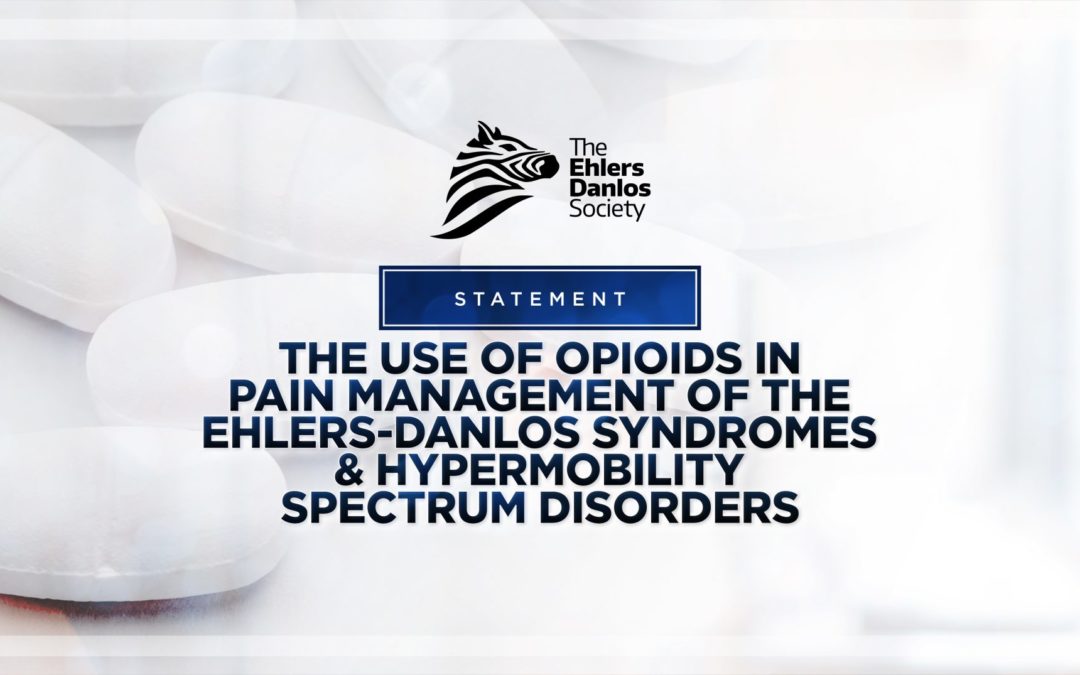Posted September 30, 2021
A statement from The Ehlers-Danlos Society and the EDS and HSD International Consortium Pain Working Group.
Pain is common among persons living with the Ehlers-Danlos syndromes (EDS) and hypermobility spectrum disorders (HSD) and is a major contributor to poor quality of life. Origins of pain in persons with EDS and HSD are multi-factorial and multiple sources of pain may be present in a single person. Multi-modal, comprehensive, and integrative treatment strategies are essential to address pain in these conditions. Treatments include, but are not limited to, medications, interventional procedures, physical therapy, acupuncture, mental health support, and complementary therapies. The range of medications include over-the-counter and prescription analgesics.
Opioids may occasionally be considered as part of an individualized comprehensive pain management plan, where the risks and benefits are carefully reviewed and discussed. Opioids have been used for many years to address both acute and chronic pain. However, societal attitudes have turned against opioid use, emphasizing its dangers.
The Ehlers-Danlos Society is fully aware that there are very real concerns about high levels of opioid prescribing and complications of long-term opioid use. Risks of opioid use include addiction, overdose, and death (1,2).
Internationally, pain management guidelines recommend that opioids should not be used for chronic pain. Clinicians have become increasingly concerned about institutional and governmental sanctions and so are restricting opioid prescribing. The Society notes however that different countries have varying policies and guidelines on the use of opioid medications in chronic pain, which will influence whether and how they are prescribed.
The Ehlers-Danlos Society is also aware that some people with EDS or HSD report that they find opioids helpful or even essential for their chronic pain management and have no or mild and tolerated side-effects (3). However, we recognize that more studies are needed to explore the effectiveness and safety of opioid analgesics in EDS and HSD, to clearly delineate the relative risks and benefits of this class of medication.
We recommend that individual circumstances be considered when a person is managing their pain well with opioids. Clinicians contemplating withdrawal of an opioid medication from a person with EDS or HSD, despite evidence of effectiveness and an absence of adverse effects, should have an alternative pain management plan that is reasonably likely to provide equivalent relief for the individual’s pain.
Shared decision making between the doctor and patient is an essential component of the therapeutic alliance for both initiation and withdrawal of pain medications.
Authored by: Dr. Isabelle Brock, Dr. Helen Cohen, Dr. Svetlana Blitshteyn, Dr. Pradeep Chopra, Michael P. Healy, Dr. Norman Marcus, and Dr. Nimish Mittal, Dr. Rebecca Bascom, Maggie Buckley, Dr. Alan Hakim, and Dr. Clair Francomano
(1) US Department of Health and Human Services/Centers for Disease Control and Prevention. MMWR, March 18, 2016. Vol. 65. No.1. doi:10.15585/mmwr.rr6501e1
(2) Edlund MJ, Martin BC, Russo JE, DeVries A, Braden JB, Sullivan MD. The role of opioid prescription in incident opioid abuse and dependence among individuals with chronic noncancer pain: the role of opioid prescription. Clin J Pain. 2014;30:557–64. doi: 10.1097/AJP.0000000000000021
(3) Demes JS, McNair B, Taylor MRG. Use of complementary therapies for chronic pain management in patients with reported Ehlers-Danlos syndrome or hypermobility spectrum disorders. Am J Med Genet A. 2020;182(11):2611-2623. doi:10.1002/ajmg.a.61837
Visit the EDS Society Website for this announcement and to subscribe to the regular newsletter.

